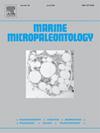Foram3D: A pipeline for 3D synthetic data generation and rendering of foraminifera for image analysis and reconstruction
IF 1.5
4区 地球科学
Q2 PALEONTOLOGY
引用次数: 0
Abstract
Foraminifera play an important role in oceanographic and paleoceanographic research. The test morphology and chemistry within species, as well as the presence or absence of certain species, are affected by environmental conditions. Classification of different species of foraminifera is a crucial yet tedious task for researchers. Deep-learning approaches can help with morphological studies and aid in species classification; however, they require large-scale datasets that are challenging to obtain and annotate because of the extremely small size and delicate handling of these microorganisms. In this work, we expand on an existing mathematical model for foraminifera shell growth to generate 3D synthetic models to aid in these studies. We define parameter spaces for the model which are intended to approximate seven randomly chosen foraminifera taxa. Along with providing an open-source code base to support other researchers in generating models and studying growth patterns, we further extend the synthetic data generation to include a rendering component that mimics two existing robotic imaging systems. We provide two use cases for our synthetic dataset. First, we show how orientation can affect the automated classification of different species and how incorporating aleatoric uncertainty indicators can help select the next views of the samples to significantly improve classification accuracy from 82% to 89%. Next, we show how a sparse set of synthetic 2D images can be used to extract 3D morphology of foraminifera using Neural Radiance Fields (NeRFs).
Foram3D:用于有孔虫三维合成数据生成和渲染的管道,用于图像分析和重建
有孔虫在海洋学和古海洋学研究中占有重要地位。物种内的测试形态和化学,以及某些物种的存在或不存在,都受到环境条件的影响。对不同种类的有孔虫进行分类对研究人员来说是一项重要而繁琐的任务。深度学习方法可以帮助形态学研究和物种分类;然而,它们需要大规模的数据集,由于这些微生物的极小尺寸和精细处理,这些数据集难以获得和注释。在这项工作中,我们扩展了有孔虫外壳生长的现有数学模型,以生成3D合成模型来帮助这些研究。我们为模型定义了参数空间,旨在近似七个随机选择的有孔虫分类群。除了提供一个开源代码库来支持其他研究人员生成模型和研究增长模式外,我们还进一步扩展了合成数据生成,以包括一个模拟两个现有机器人成像系统的渲染组件。我们为合成数据集提供了两个用例。首先,我们展示了方向如何影响不同物种的自动分类,以及如何结合任意不确定性指标来帮助选择样本的下一个视图,从而显着将分类精度从82%提高到89%。接下来,我们展示了如何使用一组稀疏的合成2D图像来提取有孔虫的3D形态,使用神经辐射场(nerf)。
本文章由计算机程序翻译,如有差异,请以英文原文为准。
求助全文
约1分钟内获得全文
求助全文
来源期刊

Marine Micropaleontology
地学-古生物学
CiteScore
3.70
自引率
15.80%
发文量
62
审稿时长
26.7 weeks
期刊介绍:
Marine Micropaleontology is an international journal publishing original, innovative and significant scientific papers in all fields related to marine microfossils, including ecology and paleoecology, biology and paleobiology, paleoceanography and paleoclimatology, environmental monitoring, taphonomy, evolution and molecular phylogeny. The journal strongly encourages the publication of articles in which marine microfossils and/or their chemical composition are used to solve fundamental geological, environmental and biological problems. However, it does not publish purely stratigraphic or taxonomic papers. In Marine Micropaleontology, a special section is dedicated to short papers on new methods and protocols using marine microfossils. We solicit special issues on hot topics in marine micropaleontology and review articles on timely subjects.
 求助内容:
求助内容: 应助结果提醒方式:
应助结果提醒方式:


